SoftRider is the Next-Generation Horseshoe
The SoftRider feature a dual density two-layer construction and is a center-loading shoe. This means that the SoftRider places the load on the center of the shoe rather than on the outside wall of the hoof. This helps increase blood flow to the hoof by encouraging the natural cyclical circulation pattern in the hoof. Providing a stable loading and unloading platform for the sole allows the hoof to center load.
The dual density of the shoe isolates the concussive force of impact with the ground on the horse’s skeletal system while also reducing strain the soft tissues in the lower leg. The forward and medial/lateral breakovers allow for quicker transition through the step, and improved multi-directional traction.
SoftRiders are a useful tool for horses with issues like laminitis, aged horses suffering from navicular syndrome and ringbone, and they’re also perfect for long-term use on all performance horses. SoftRider shoes have been tested at top veterinary hospitals and used by the best performance horses in the world. across the country and are now available for anyone to purchase.
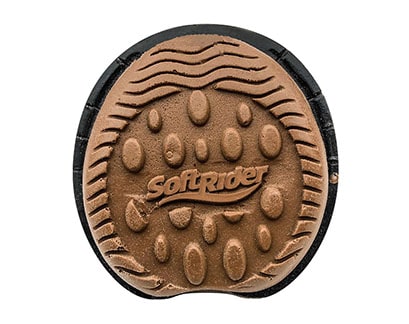
SoftRider Gel Max
This shoe has a breakover wedge potential of 0-19 degrees. It has the most rockered toe and the highest convex profile of the available SoftRider shoes. This shoe also has a designated neutral resting platform beneath the center load which allows a horse to find the most comfortable resting position. The dual density design allows for the most support and shock absorption for a lame horse. This shoe is most suited for horse suffering from laminitis or navicular syndrome.
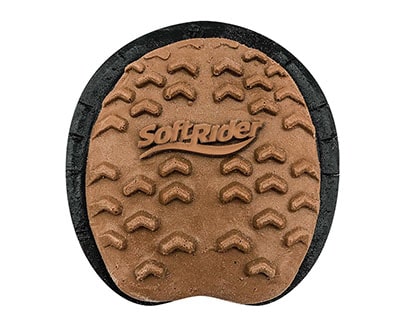
SoftRider Gel Arena
This shoe has a low profile, aggressive tread pattern, and forward, medial, and lateral breakover wedge potential of 0-9 degrees. The dual density, center loading support system in this shoe makes it ideal for performance and general riding in sound, slightly tender footed, or aged horses.
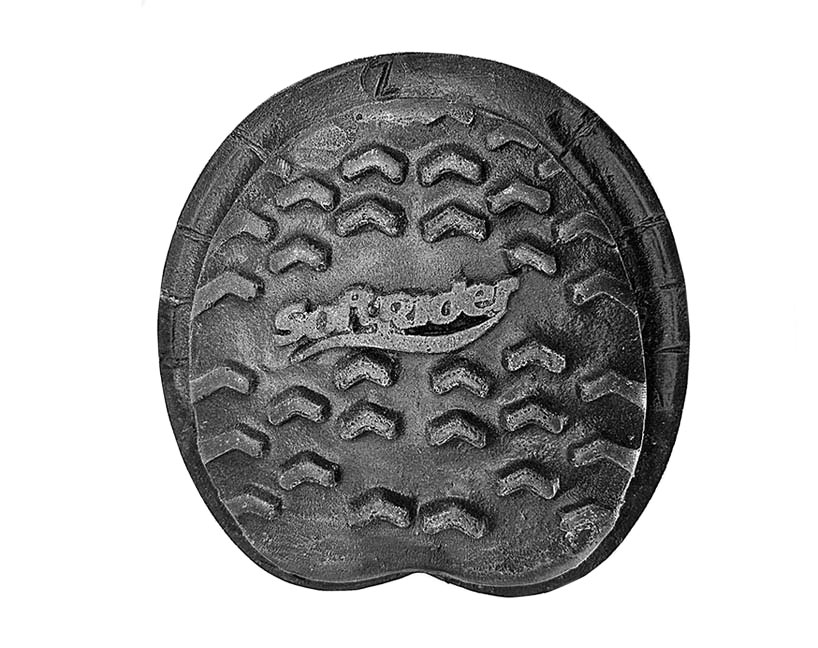
SoftRider Carbon Fiber Arena
This shoe has a dual density design for shock absorption and supported circulation throughout the hoof. The shoe provides a peremeter breakover edge around 270 degrees of the circumference of the shoe. The Softrider Carbon features a breakover potential wedge of 0-9 additional degrees. The polymer is infused with carbon fiber to make the ground contact wear surface the most durable and firmest SoftRider option for sound competition horses and general riding.
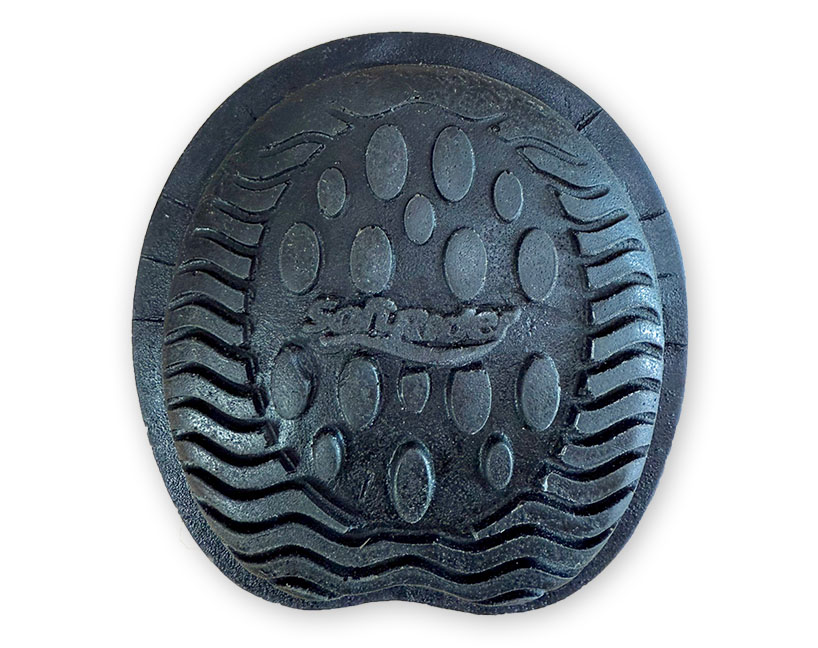
SoftRider Draft Carbon Max
The Draft Carbon Max shoe takes the technology introduced in the SoftRider Carbon shoes and SoftRider Gel Max shoes, combining both to make a shoe large and durable enough for large warmblood and draft horses.
Technical Features
All SoftRiders feature a patented dual-density design that provides a
rigid base for the whole hoof while absorbing shock and delivering better traction than
traditional steel shoes.
Enhanced Breakover
The SoftRider is designed to provide enhanced breakover from front to back, thus easing tension on the deep digital flexor tendon.
Performance Athletes Benefit
The SoftRider's patented design benefits performance horses by spreading the load over the entire hoof, not just the perimeter, thus reducing painful leverage on soft tissues.
Nail/Casting Edge
The elevated edge enables a practitioner to temporarily mount the SoftRider with casting tape. It can be also shaped with a rasp for a custom fit and features nail location guide lines.
Laminitis / Protecting the Lamina
The SoftRider's sole allows the foot to roll fore and aft and side to side slightly, enabling laminitic horses to find comfortable footing and increasing mobility.
Neutral Resting Position
The SoftRider's substantial sole provides a comfortable, neutral resting position for the foot.
Center Loading
The SoftRider is a center-loading, accommodative shoe that supports the entire foot and reduces potential injuries to soft tissues.
Shock Absorbing Base Material
The SoftRider's shock absorbing base helps soften the blow of each step for performance horses and older or navicular horses alike.
Eases Tendon Stressors
The SoftRIder's design helps ease the strain on tendons and lessens the pull on ligaments.
SoftRider Overview with Dr. Joe Stricklin
Equine veterinarian Dr. Joe Stricklin explains how the pliability and center-loading mechanics of SoftRiders differentiate them from other shoes, and how those same features help with lateral breakover and reduce concussion on all of the bones, joints and tendons of the foot and lower leg. “From what I’ve see, there’s a use for these shoes everywhere.”
Applying SoftRiders
The SoftRider can be screwed, nailed or glued to the hoof, and—like a traditional horseshoe--should be installed by a farrier or veterinarian. SoftRiders are sized like traditional horseshoes, and your horse can still wear Soft Ride horse hoof boots and use the Ice Spa while wearing Soft Rider center-loading shoes.
SoftRider Frequently Asked Questions
What is the difference between a SoftRider and a regular horseshoe?
The SoftRider shoe is a center-loading shoe, which means it takes the weight that usually rests solely on the hoof wall and distributes it across the entire hoof. The base of the shoe rests directly against the sole. This allows for loading and unloading of the sole (just like the Gel Orthotic in a Soft Ride Comfort Boot), which stimulates circulation throughout the hoof and leg when standing or moving. SoftRiders also allow multi-directional breakover, which minimizes ligament and tendon strain when moving in any direction.
How are SoftRiders applied?
SoftRiders can be cast, glued, or nailed on like a traditional shoe by a vet or farrier. In most cases, they will first wrap the shoe in place to assure proper placement. They will then will mark nail locations that are most beneficial to the horse. They’ll remove the shoe to pre-drill nail holes and then nail the shoe like a traditional shoe. Finally, they will seal the back of the shoe with farrier silicone (or a similar material), leaving an open cavity in front of the frog to allow for loading and unloading of the hoof sole.
Which SoftRider model is best for my horse?
Your vet or farrier can best determine which SoftRider model is best for your horse. The SoftRider Gel Max has a taller profile than the Gel Arena. This allows more breakover, which enables a horse to find the most comfortable resting position for the foot, and is thus more suited for laminitic and navicular horses. The SoftRider Gel Arena has a lower profile and aggressive tread pattern, which makes it a great choice for competition, trail, pleasure and general riding.
Can I ride/perform in SoftRiders?
Yes. SoftRiders are specifically designed to be worn for work and performance. Several NFR riders use the SoftRider Gel Arena on horses competing in roping, barrel racing, cutting, reining and more. English riders use the Gel Arena for dressage, jumping, and other equestrian events. And everyday owners use the SoftRider for activities like work, ranch and trail riding.
Can I still use my Soft Ride boots with SoftRider shoes?
Not yet. We are working on developing a special gel orthotic for the Soft Ride Comfort Boot that would work specifically with the SoftRider shoe.
How SoftRiders Work
Centering the Load - The SoftRider’s construction concentrates the horse’s weight in the middle of the hoof, increasing blood flow to and from the foot. This is the same principle used in the deep gel orthotics in Soft Ride’s Equine Comfort Boots.
Helps Sore-Footed Horses
Equine veterinarian Dr. Joe Stricklin, and farrier Craig Doolittle, demonstrate how SoftRiders helped a sore-footed horse by providing cushioning and ease of breakover.
Core Support
Equine veterinarian Mark Silverman specializes in equine podiatry and likes the SoftRider because it is designed to support the core of the hoof, aiding in circulation that's important to the function of the foot. Silverman notes that the SoftRider is easy to work with and can be cut and ground for a custom fit to meet the needs of the individual horse.
Better Lateral Breakover
SoftRiders help with lateral breakover in a horse’s stride. Unlike a traditional peripheral loading shoe, SoftRiders allow a horse’s foot to roll over naturally, thus reducing strain and stress on tendons. The SoftRider’s rubber tread also provides better grip than traditional shoes on all surfaces. The video on the right shows several before and after examples of sore-footed horses that were able to return to normal activities after being shod with SoftRiders.
This presentation explains how SoftRiders help with lateral breakover.
SoftRiders helped Fred, a former barrel racer, get back on his feet and back to his old, friendly self.
Getting Sound with SoftRiders
X-rays explain how SoftRiders helped Copper go from lame to sound in seven days.
Help for Barefoot Horses
Dr. Joe Stricklin explains how SoftRiders helped a barefoot horse that hadn’t been trimmed well.
Applications without nails
Stuart Muir, resident farrier for Rood and Riddle, introduces the three methods he uses for applying SoftRider Max shoes to laminitis horses. These methods include using vet wrap or elastikon to apply the shoe to the hoof with impression material, casting the shoe on with traditional casting tape, and using a kevlar cuff screwed to the shoe for glue application to the hoof wall.
Temporary SoftRider Applications
Stuart Muir, resident farrier for Rood and Riddle, demonstrates applying the SoftRider Max Shoe with impression material, a pad, and vet wrap or elastikon tape. Muir strategically floats the hoof with impression material across the frog to allow for proper central sole loading. He then applies a medical-pad before aligning shoe and vet wraping the shoe to the hoof tightly using the casting edge of the shoe. This is the quickest and most temporary application for horses suffering from acute laminitis.
Casting on SoftRiders
Stuart Muir, resident farrier for Rood and Riddle, demonstrates applying the SoftRider Max Shoe with casting tape and impression material. Muir minimally casts the hoof and then indirectly glues the shoe to the cast instead of directly glueing to the hoof wall. This casting method allows for the most balanced mechanics and breakover for chronic laminitic cases
SoftRider Application with cuff and casting
Stuart Muir, resident farrier for Rood and Riddle, demonstrates applying the SoftRider Max Shoe with a kevlar cuff. Muir applies the kevlar to the SoftRider Max shoe with sheetrock screws. He removes the part of the cuff that would cover the heels before glueing the cuff to the hoof wall and adjusting position as necessary when wrapping the hoof to set the glue. This method is the fastest long wearing application of the shoe to a laminitis hoof.
Sizing Chart
SoftRider Gel Max, Gel Arena, and Carbon Fiber Arena are available in sizes 000-5. SoftRider Draft Carbon Max is available in sizes 6-8
| Size | Width | Length |
|---|---|---|
| 000 | 4 3/8” - 111mm | 4 1/2” - 114mm |
| 00 | 4 3/4” - 121mm | 4 7/8” - 124mm |
| 0 | 4 7/8” - 124mm | 5 1/8” - 130mm |
| 1 | 5 1/4” - 133mm | 5 1/4” - 133mm |
| 2 | 5 3/8” - 137mm | 5 5/8” - 143mm |
| 3 | 5 5/8” - 143mm | 5 7/8” - 150mm |
| 4 | 5 7/8” - 150mm | 6 1/4” - 159mm |
| 5 | 6 1/8” - 156mm | 6 3/8” - 162mm |
| 6 | 6 5/8” - 169mm | 6 7/8” - 175mm |
| 7 | 7 1/4” - 184mm | 7 1/2” - 191mm |
| 8 | 8 3/8” - 213mm | 9 1/8” - 235mm |
The sizing chart measurements are the maximum recommended hoof dimensions of a freshly trimmed hoof. SoftRider Shoes are made by hand so minimal variations in measurements are possible due to the finishing process. Your farrier can make alteration to the shoe to fit your horse.
SoftRiders Testimonials
Here at Soft Ride, we receive a steady stream of thank-you notes and letters from customers who want to share how their favorite four-legged friends have been helped by Soft Ride. Take a look at some of these amazing stories and, if you're so inclined, please send your Soft Ride success story to: sales@softrideboots.com.
Your SoftRiders have been life changing for my horse and I."
Cowboy is an 18-year-old Mounted Shooting horse. He loves his job, loves to run and takes care of me every step of the way. For the last 2 years I've been battling lameness or just not 100% sound issues. He had xrays and I was told he may have some navicular changes. I took him to be evaluated by a vet who treats the Olympic Equestrian Team. She did a huge workup....we injected the navicular bursa, he got a round of osphos, and a couple rounds of shock wave therapy. When Cowboy feels good, he LOVES to run! I have never had to push this horse because running is his thing. If he hurts....he doesn't want to run or shoot. So, for about a month after seeing this vet, he felt great. However, not soon after he started short stepping on me with a lack of "want to."
We have had to significantly slow down the last two years and when we did compete, I had to use bute, which I hate!!
I discovered SoftRiders a couple months ago. I had to battle with my farrier a bit as he still felt he could try other modalities to get him right. Not to mention, he didn't really feel the concept was new. Well, all his trial and errors failed, so! I ordered two pairs of SoftRider shoes. We put them on him a week ago, and my sister was in town and we went for a trail ride. I often breeze him around the pastures, and when his feet hurt he doesn't love this idea. So, off we went, and when we hit the fields (my sister isn't much of an equestrian) she went flying past me on Cowboy. She would get him to come back and he would take off again. I thought maybe she was squeezing him so I rode him two days later. Same thing happened to me. Obviously, I had control over him but he basically said, I want to run!!! So, we ran!!
I then noticed after all my rides he was no longer pointing his feet. He has pointed his feet to offload them for at least a year. My farrier told me it was just a habit at this point. Well, I guess in my heart I knew better! My horse no longer points to take turns getting pressure off each hoof. He stands perfectly square even after barrel-assing around the 100 acres I ride on!!
Sonya Morse
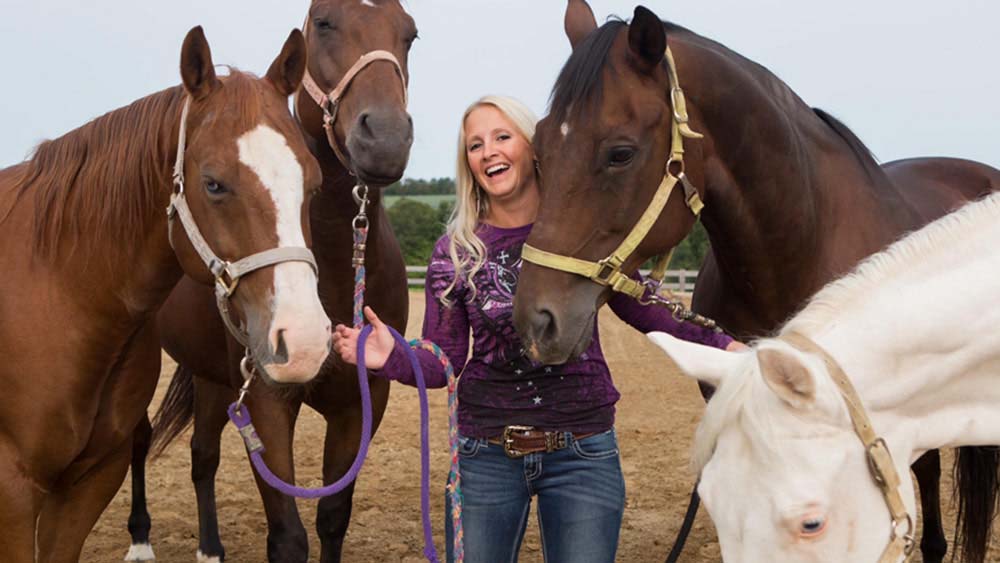
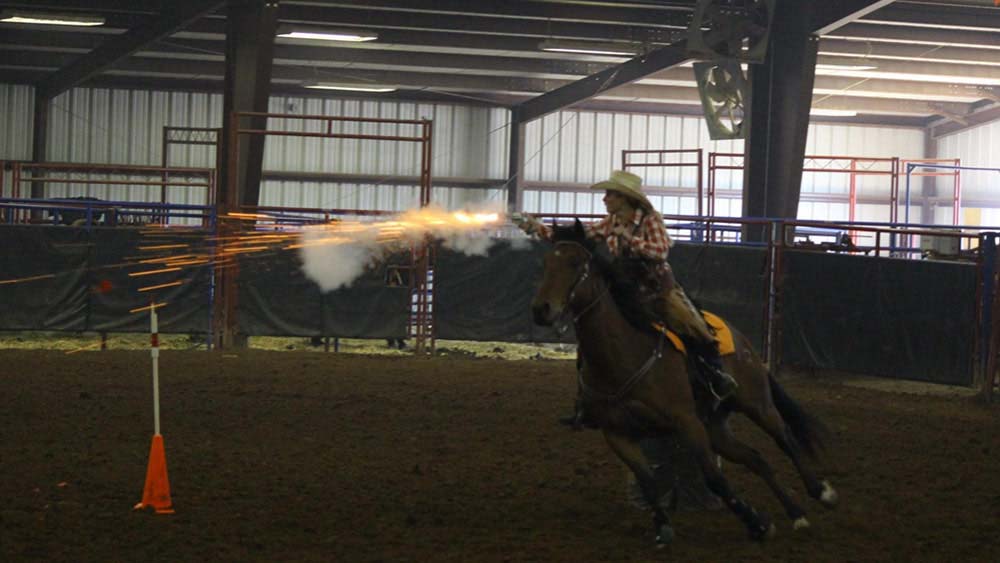
I wanted to send you an update on the SoftRider shoes. We've had great success with them through the last few settings on my gelding, Fred. My farrier enjoys working with the shoes; he says they're very easy to put on.
Before putting on the SoftRiders, Fred not even want to put weight on his worse foot (the left front). I was curious if his improvement was due to the shoes or him getting better on his own in time and the cold weather reducing inflammation. Well as soon as my farrier took his left front shoe off after the last setting, Fred immediately was pointing his toe and wanting to get weight off that foot again. So that was my answer - the shoes are making a huge difference. He is finally back to his old self and comfortable again. I just wanted to give you an update on the shoes and say thank you again, very much, for giving my horse a chance to be comfortable and happy again. He has accomplished so much for me, and it makes me so happy to see him feeling good again. I don't know if he will ever make it back to barrel racing, but we are hoping to start roping on him again. I sure hope you continue to make these shoes, because they really are a game changer! Thank you
Kollie Teigen
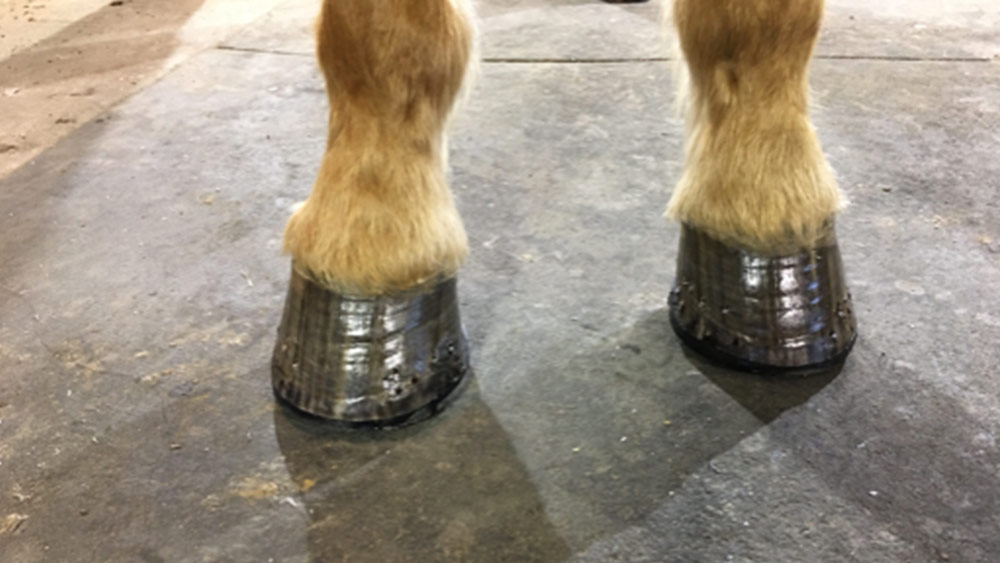
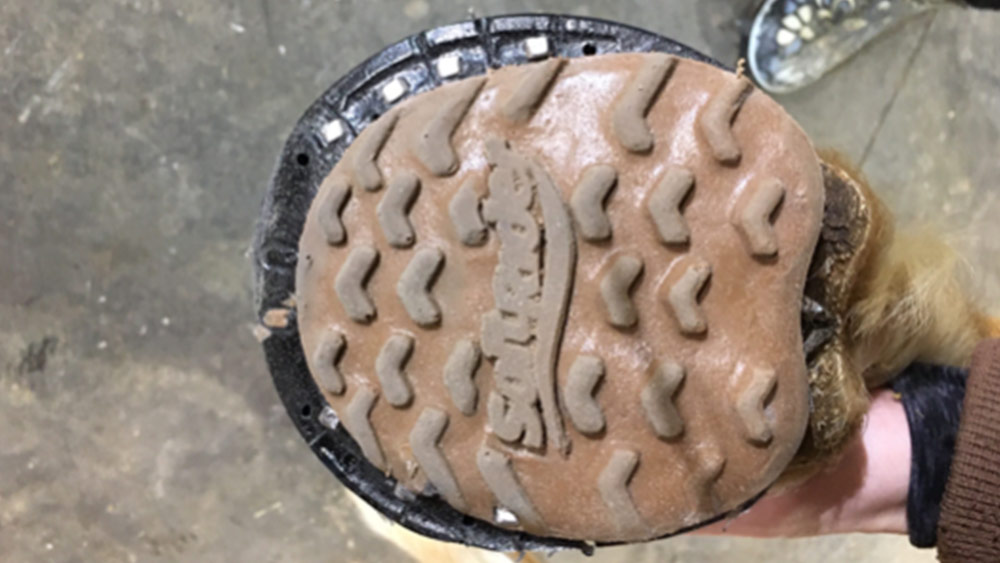
Dr. Raul Bras at Rood & Riddle put the SoftRider shoes on our 8-year-old barrel horse that has arthritis beyond her age in her coffin bone on left front foot. This has helped considerably along with poly g and a few other things. We know the shoe was effective though because she was quite a bit more sound right away before the poly g and other things really had time to work.
Dustin Whitesel
SoftRiders aren’t just for a sore horse, but I have found tremendous use for them for sore horses. Anything from navicular horses, thin soles, poor angles, ring bone. Time after time I’ve found that horses have responded terrifically to these shoes. From what I’ve seen, there’s a use for these shoes everywhere.
Dr. Joe Stricklin

Profile Login
If you are an existing Soft Ride customer, please login to your account.
Password Recovery
Please enter the email address of the account that needs recovered. An email with the password will be sent to this address.
Password Recovery Sent
If the email address specified is found in our records, instructions will be sent to . Please check your SPAM folder if you haven't received an email in a few moments.

Logout of Soft-Ride?
Are you sure you want to logout of your account?

Product added to your cart!
We just added an item to your cart. Would you like to keep shopping or checkout?
